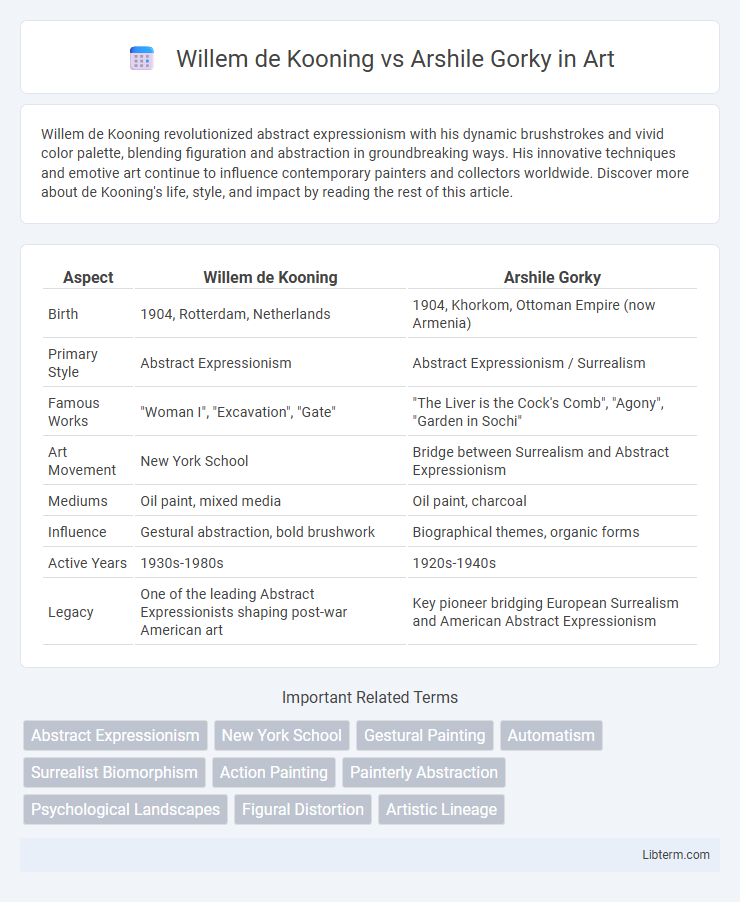Willem de Kooning revolutionized abstract expressionism with his dynamic brushstrokes and vivid color palette, blending figuration and abstraction in groundbreaking ways. His innovative techniques and emotive art continue to influence contemporary painters and collectors worldwide. Discover more about de Kooning's life, style, and impact by reading the rest of this article.
Table of Comparison
| Aspect | Willem de Kooning | Arshile Gorky |
|---|---|---|
| Birth | 1904, Rotterdam, Netherlands | 1904, Khorkom, Ottoman Empire (now Armenia) |
| Primary Style | Abstract Expressionism | Abstract Expressionism / Surrealism |
| Famous Works | "Woman I", "Excavation", "Gate" | "The Liver is the Cock's Comb", "Agony", "Garden in Sochi" |
| Art Movement | New York School | Bridge between Surrealism and Abstract Expressionism |
| Mediums | Oil paint, mixed media | Oil paint, charcoal |
| Influence | Gestural abstraction, bold brushwork | Biographical themes, organic forms |
| Active Years | 1930s-1980s | 1920s-1940s |
| Legacy | One of the leading Abstract Expressionists shaping post-war American art | Key pioneer bridging European Surrealism and American Abstract Expressionism |
Introduction: De Kooning and Gorky – Titans of Abstract Expressionism
Willem de Kooning and Arshile Gorky are pivotal figures in Abstract Expressionism, each shaping the movement with distinct styles and techniques. De Kooning's aggressive brushwork and fragmented forms contrast with Gorky's lyrical abstractions and biomorphic shapes, reflecting diverse approaches to emotion and spontaneity. Their contributions significantly influenced mid-20th-century American art, cementing their legacies as titans of Abstract Expressionism.
Early Lives and Influences
Willem de Kooning was born in Rotterdam, Netherlands, in 1904 and began his artistic training at the Rotterdam Academy of Fine Arts before immigrating to the United States in 1926, where he was influenced by urban American life and jazz culture. Arshile Gorky, born in the Ottoman Empire in 1904, experienced trauma and displacement due to the Armenian Genocide, later moving to the U.S. where he absorbed surrealism and modernist European art alongside American regionalism. Both artists' early lives were marked by cultural dislocation, shaping their abstract expressionist styles through a fusion of European avant-garde techniques and American modernist trends.
Artistic Philosophies Compared
Willem de Kooning emphasized spontaneous, gestural abstraction reflecting raw emotion and dynamic movement, aligning with Abstract Expressionism's focus on personal expression. Arshile Gorky merged Surrealist imagery with biomorphic forms, aiming to evoke subconscious memories and emotions through symbolic abstraction. Both artists prioritized emotional depth but diverged as de Kooning favored energetic improvisation while Gorky pursued lyrical, dreamlike compositions rooted in personal history.
Signature Styles: De Kooning’s Energetic Brushwork vs. Gorky’s Poetic Forms
Willem de Kooning's signature style is defined by energetic brushwork characterized by vigorous, sweeping strokes that convey dynamic movement and emotional intensity. In contrast, Arshile Gorky's style emphasizes poetic forms with fluid, biomorphic shapes that blend abstraction and surrealism, creating a lyrical, dreamlike quality. De Kooning's work is rooted in action painting with a focus on raw energy, while Gorky's compositions evoke delicate balance and symbolic resonance through carefully layered forms.
Key Works: Iconic Paintings Side by Side
Willem de Kooning's "Woman I" (1950-52) showcases his dynamic, aggressive brushwork and abstracted female form, emphasizing intense emotion and movement. Arshile Gorky's "The Liver is the Cock's Comb" (1944) features surreal, biomorphic shapes and vibrant colors, blending abstraction with personal symbolism. Both artists significantly influenced Abstract Expressionism, with de Kooning's raw energy contrasting Gorky's lyrical, organic compositions in their iconic paintings.
Influence of Surrealism and European Modernism
Willem de Kooning and Arshile Gorky both drew extensively from Surrealism and European Modernism, shaping Abstract Expressionism's evolution. Gorky integrated biomorphic forms and automatism inspired by Surrealist techniques, directly channeling artists like Picasso and Miro. De Kooning synthesized gestural brushwork and figurative elements influenced by European Modernists such as Cezanne and Matisse, creating dynamic abstraction with deep psychological complexity.
Their Relationship: Friendship, Rivalry, and Mutual Inspiration
Willem de Kooning and Arshile Gorky shared a complex relationship marked by both friendship and rivalry, which significantly influenced the development of Abstract Expressionism. Their mutual inspiration is evident in Gorky's biomorphic forms and de Kooning's dynamic brushwork, blending surrealism and expressionism in innovative ways. This interplay of admiration and competition fueled their artistic evolution during the mid-20th century New York art scene.
Legacy in the New York Art Scene
Willem de Kooning revolutionized the New York art scene with his dynamic Abstract Expressionist style, influencing generations of artists and solidifying the city's status as a global art center. Arshile Gorky's pioneering fusion of surrealism and abstraction laid foundational elements for Abstract Expressionism, deeply impacting the development of postwar American art. Both artists' legacies endure through major museum collections, influential exhibitions, and their roles in shaping New York as the epicenter of modern art innovation.
Critical Reception: Then and Now
Willem de Kooning received widespread acclaim during the 1950s as a leading figure in Abstract Expressionism, praised for his dynamic brushwork and complex compositions, which continue to influence contemporary art critics. Arshile Gorky, initially overshadowed despite his pioneering role in merging Surrealism with Abstract Expressionism, has gained significant posthumous recognition for his lyrical style and emotional depth, reshaping his legacy in modern art history. Current critical reception acknowledges both artists' profound impact, with de Kooning celebrated for his bold innovation and Gorky recognized for his foundational contributions and tragic narrative.
Impact on Contemporary Abstract Art
Willem de Kooning revolutionized contemporary abstract art with his aggressive brushwork and dynamic figuration, influencing the development of Abstract Expressionism and pushing the boundaries of form and color. Arshile Gorky's impact lies in his pioneering fusion of Surrealism and abstraction, introducing biomorphic shapes and emotional intensity that shaped the trajectory of American modernism. Both artists fundamentally altered artistic expression, with de Kooning's gestural intensity and Gorky's lyrical abstraction serving as foundational pillars for future generations of abstract painters.
Willem de Kooning Infographic

 libterm.com
libterm.com